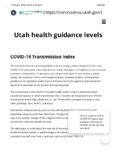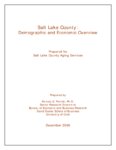TO
| Title | Date | Subject | Description | ||
|---|---|---|---|---|---|
| 1 |
 |
UPED index to parameters and exogenous variables data sources and calibration procedures | |||
| 2 |
 |
Utah economic and demographic profiles | 1988-08 | Data users in the public and private sectors frequently are in need of economic and demographic information about the State of Utah. More often than not, however, the needed data is found in numerous government reports, located at several different places, for variousy ears. This report, Utah Econom... | |
| 3 |
 |
Directory of State of Utah statistics 1971 | 1971-09 | The Directory of State of Utah Statistics has been developed in response to the need for a fairly comprehensive guide to statistical information published by the State. The Directory is intended to fulfill two objectives. The first and major objective is to make available to policy makers, planners ... | |
| 4 |
 |
Utah health guidance levels | COVID-19; transmission | Snapshot of the county-by-county transmission levels of COVID-19 | |
| 5 |
 |
Salt Lake County: demographic and economic overview | 2006-12 | Salt Lake County; Utah; Demographics; Aging; Dependency ratio; Foreign born; Immigrants; Age structure; Age waves; Occupation; Labor force participation; Sex ratio; Educational attainment; commuting | Salt Lake County is the economic, political, and cultural center of Utah. The county is currently home to nearly 40 percent of Utah residents and generates about half of all jobs in the state. It remains the most populous county, with a million of the state's 2.6 million residents,1 and its daytime ... |
| 6 |
 |
Projections for school population and teacher demand in the State of Utah for the period 1970-2000 | 1975 | This study deals with probable future trends in student enrollment, accoroing to age, sex, grades, and school levels, for different geographic areas, and teacher demand for the elementary and secondary levels of school in Utah from 1970 to the year 2000. For the secondary level schools, information ... | |
| 7 |
 |
Population projections by age and sex for Utah counties 1970-2000 | 1976-12 | Future trends in population must be a factor in guiding long-term socioeconomic planning efforts in order for the planning to be effective. To be realistic, economic and social planning must take into account not only the future size, but also the composition and distribution of the population. ... | |
| 8 |
 |
The Utah process phase II report: preparation for analysis of the alternative futures: development of tools and concepts | 1972-04 | This report presents the final specification of the five Alternative Futures and the method of dealing with the social and political events to the Utah Systems Planning Group and the Utah Systems Work Committee. Both elements are of central importance to the Utah Process since they present the possi... | |
| 9 |
 |
Areawide and local effects of tar sands development at the Sunnyside site in Utah: A socioeconomic analysis | 1984-04 | The Combined Hydrocarbon Leasing Act of 1982 (Public Law 97-78) provides guidelines for converting federal oil and gas leases to combined hydrocarbon leases in Special Tar Sands Areas (STSAs). The STSAs are designated by the U.S. Department of the Interior as areas that contain substantial deposits ... | |
| 10 |
 |
State of Utah economic & demographic projections 1994: highlights | 1994-10 | This document reviews and examines the major conclusions from the larger, more detailed report, State of Utah Economic and Demographic Projections 1994. The Governor's Office of Planning and Budget (GOPB) publishes these long-term projections biennially. The primary purpose of the projections is to ... | |
| 11 |
 |
Utah State preliminary development plan | 1969-03 | The Four Corners Economic Development Region, consisting of a 92-county area in Arizona, Colorado, New Mexico, and Utah, was established December 19, 1966, under Title V of the Public Works and Economic Development Act of 1965. On September 19, 1967 the Four Corners Regional Commission was created ... | |
| 12 |
 |
QGET quality growth efficiency tools scenario analysis | 1999-03 | The Greater Wasatch Area is currently home to 1.6 million people (a population slightly smaller than the Portland metro area). By 2020, the population is expected to increase to 2.7 million people (a population roughly equivalent in size to the current population of the San Diego metro area). Th... | |
| 13 |
 |
Population projections Utah and Utah's counties | 1967-12 | We would jointly like to thank those who contributed to the overall realization of this report, as well as individually express our appreciation to those who provided assistance to the separate projects. Mr. Robert Huefner, who as the State Planning Coordinator arranged the financial support, was of... | |
| 14 |
 |
The economic & demographic impacts of the intermountain power project | 1982-04 | This report presents economic and demographic projections for the two-county (Millard and Juab) area to be impacted by the Intermountain Power Project located in western Millard County, Utah. The intermountain Power Agency has been planning the construction of the IPP project for quite some time. | |
| 15 |
 |
1984 baseline projections executive summary | 1984-09 | ||
| 16 |
 |
Economic, demographic and fiscal impacts of closing Hill Air Force Base: a statewide and regional analysis | 2004-04 | The upcoming round of Defense Base Closure and Realignment (BRAC) is threatening the existence of Hill Air Force Base (Hill AFB). The Department of Defense is aggressively approaching this round of BRAC in its attempt to eliminate 20% to 25% of current capacity. The purpose of this study is to asses... | |
| 17 |
 |
Economic & demographic futures 1980-2000 | 1980-01 | Special acknowledgement is appropriate for the efforts of the Community Planning Policy Committee which provided continual guidance to the Water Quality staff over a six month period; in addition to Jean Watanbe, Office of the State Planning Coordinator, Brad Barber and Greg Selby formerly with the ... | |
| 18 |
 |
Utah:2000 a high development scenario | 1980-03 | This report was prepared, under the direction of Paul Parker and Jeannie Watanabe, by members of the Comprehensive Planning Section, State Planning Coordinator's Office. Population projections and other statistical data were prepared by Jeannie Watanabe and Brad Barber. Dave Conine, Paul Parker, Gle... | |
| 19 |
 |
Demographic patterns and characteristics of Utah | The historical emphasis on numbers rather than on the quality and make-up of the population, though scarcely justifiable, is understandable. Concentration on a single magnitude certainly simplifies the projection of a population. To illustrate, the world population is now approximately 3.5 billion. ... | ||
| 20 |
 |
Issues of fertility in Utah | 1988-08 | The recent decline in births in Utah has generated much interest. Local newspapers have reported the decline and speculated about possible reason, and demographic researchers have struggled to explain the trend. The question is why, after 15 years of increases, did births begin to decline in the ear... | |
| 21 |
 |
Energy development in the Uintah Basin: economic and demographic impacts | 1981-07 | This report, "Energy Developments in the Uintah Basin: Economic and Demographic Impacts," is one of aseries of reports issued by the State Planning Coordinator's Office that are designed to support comprehensive planning and the development of a Utah growth management strategy. The report is intende... | |
| 22 |
 |
State of Utah economic and demographic projections: 2000-2030, 2000 baseline highlights | 2001-01 | ||
| 23 |
 |
1986 baseline projections | 1986-06 | ||
| 24 |
 |
Demographic trends and high development "The Utah MX Baby Bomb" | 1981-04 | ||
| 25 |
 |
State of Utah economic & demographic projections 1988 | 1988-04 | This is the updated projection of "baseline" or the "most likely" economic and demographic conditions through the year 2010 for the State of Utah, its counties, and its multi-county planning districts (MCD's) Rapidly changing economic and demographic circumstances in recent years have exacerbated th... |
